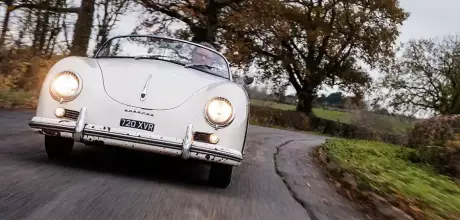1957 model-year Porsche 356 A Speedster
The unsullied looks and low mileage of this 356 A Speedster caught the eye of former McLaren Formula One team manager, Alastair Caldwell. His first act on buying it? To drive seven thousand miles around Europe and North Africa, taking in two classic rallies along the way...
Words Johnny Tipler
Photography Dan Sherwood
USED AS INTENDED
A well-travelled 356 A Speedster
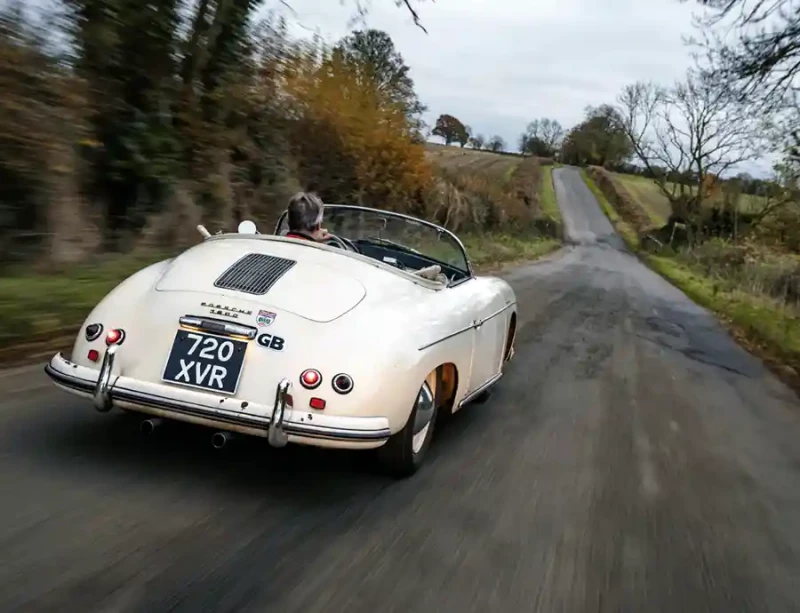
There’s nothing like jumping in at the deep end. When Alastair Caldwell took delivery of this 356 A Speedster, he immediately took off to Europe with his girlfriend, the pair determined to indulge in historic rallying. Before he tells us the tale, an overview of the car we’re pointing our cameras at. This 1957 model-year 356 A Speedster left the factory on September 21st 1956 and was promptly delivered to the famous Hoffman Motor Car Company in New York. It then spent five decades in the custody of a marque enthusiast in Baltimore, Maryland, before being relieved from a storage container in 2012. A subsequent mechanical refurbishment included an overhaul of the matching-numbers 1.6-litre flat-four and its original four-speed transaxle. Finished in off-white with black leatherette seats, the car also carried an off-white softtop, side screens, body-coloured wheels, so-called ‘baby moon’ hubcaps, distinctive beehive-style taillights, a single side mirror and chrome headlight grilles. The car was sold with a copy of its original Kardex and a clean Massachusetts title.
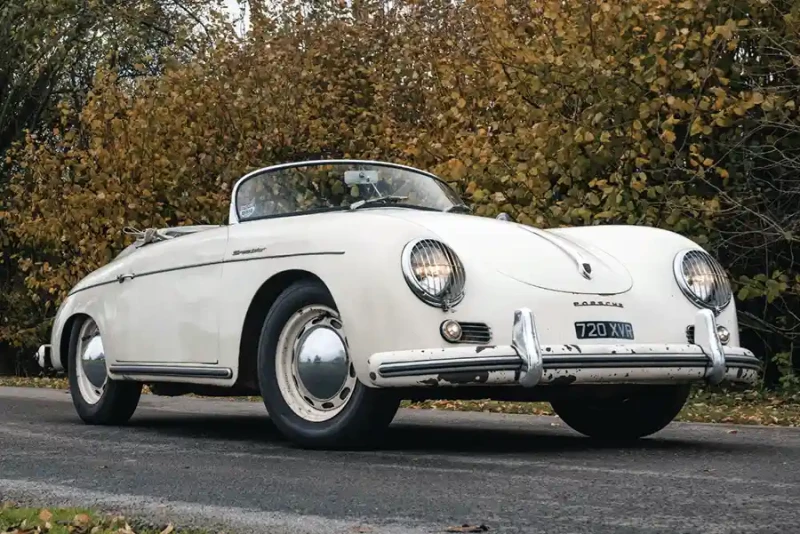
The Reutter bodywork was repainted in 1969, far enough back in time for it to have sustained a few chips and dings, plus patches of red oxide primer, more of which later. The fifteen-inch KPZ steel wheels are mounted with 165-width Vredestein Sprint Classic tyres. Date codes from August 1956 are discernible on all four wheels, as well as the matching spare. The brakes are hydraulic drums, last rebuilt in 2012.
The cabin furniture comprises fixed-back bucket seats upholstered in black leatherette with white piping, as well as matching trim on the door panels and dash pad. Oatmeal square-weave carpeting lines the footwells, seat backs and sills. Black rubber mats cover the floors. The factory-fitted one-piece wooden pedal board remains, while the factory two-spoke steering wheel fronts a body-coloured metal dashboard housing green-letter VDO instrumentation, including a central 6,000rpm tachometer and 120mph speedometer.
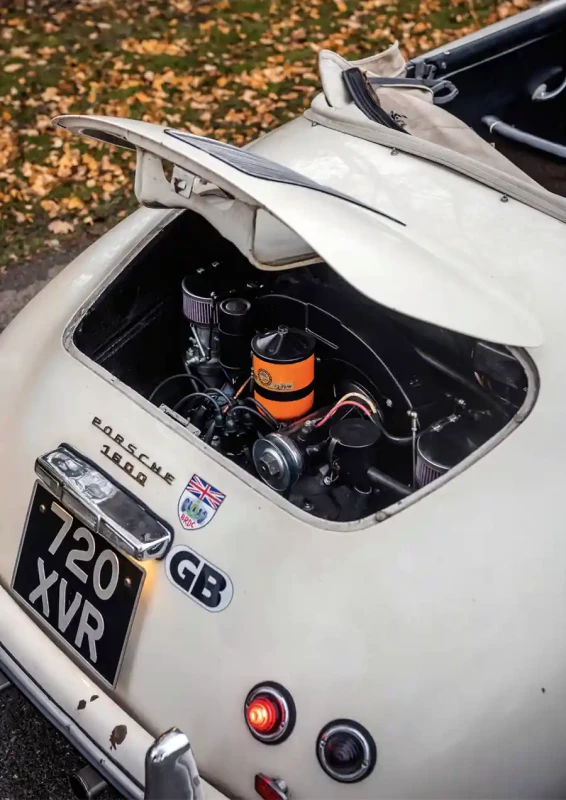
The 1,582cc flat-four is stamped 62940 and is fed by twin Solex 32 PBIC downdraft carburettors. The Type 644 four-speed manual transaxle is stamped with serial number 11345. In January 2021, the car was imported on Alastair’s behalf by Oxfordshire-based classic Porsche restoration specialist, Greatworth Classics, a company you’ll have read about elsewhere in this magazine, and who handled all the shipping and paperwork.
Readers of a motorsport persuasion might know Alastair was Bruce McLaren’s mechanic from 1967, leading to appointment as McLaren Formula One team manager in the mid-1970s. This was the championship-winning era of Emerson Fittipaldi and James Hunt. Alastair took over from Teddy Mayer, who went Stateside to look after McLaren’s Can-Am programme. Nowadays, Alastair is a keen exponent of historic rallying.
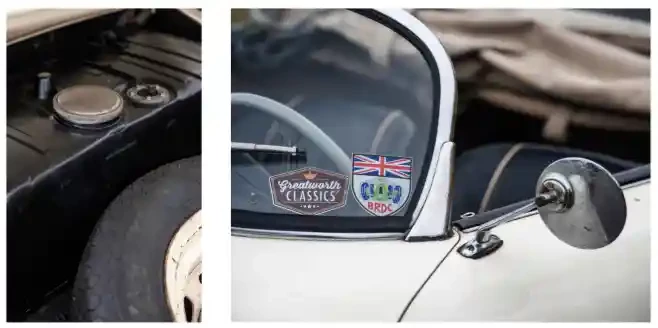
He doesn’t mind admitting he’s also a relatively recent convert to Porsche sports cars, having previously dismissed them for having their engines in the ‘wrong place’. “I saw this Speedster advertised for sale on the Bring a Trailer website,” he recalls. “It really appealed to me, primarily because it was an untouched car, but also because it had covered so few miles during its six-decade life. I paid $400,000, which was stupidly expensive, but I bought it anyway.” He’s certainly glad he did. “I really enjoy the car. Its handling is great. It might be equipped with only a four-speed gearbox, but each ratio is perfectly considered. It’s a delight to drive long distances, largely due to the fact the engine and the gear ratios are so fantastically complementary to one another. Third gear is good for hill climbing, and the engine will happily run at 80mph all day long.” Befitting of a former McLaren man, when Alastair is on the move, he doesn’t like to hang about.
The roof is in excellent order, much to the delight of his girlfriend. “I also rally a 1938 Alfa Romeo 6C SS Torpendino,” he tells us. “The Alfa has no hood at all. When it rains, you just have to suffer getting wet and cold. In contrast, the 356 not only has a roof, but also a functioning heater! My girlfriend loves this Porsche. We can put the hood up and get pretty comfortable, even in poor weather.”
MOVIE MAGIC
Greatworth Classics boss, Angus Watt, sets the scene. “Alastair owns a variety of different cars,” he explains. “At last count, his fleet comprised more than twenty vehicles, incorporating a good number of Porsches, including a 993 Cabriolet, which is his daily driver. He also owns a 928, a Cayenne Turbo and a 914/6. He loved the look of the Speedster and was determined to buy it. The car arrived at our workshops in April 2021. It had been repainted in the late 1960s and had since accumulated lovely patina, which Alastair wanted us to preserve. There were, however, red oxide patches on the offside front wing, which we were asked to eliminate. Initially, we couldn’t understand why they were there.”
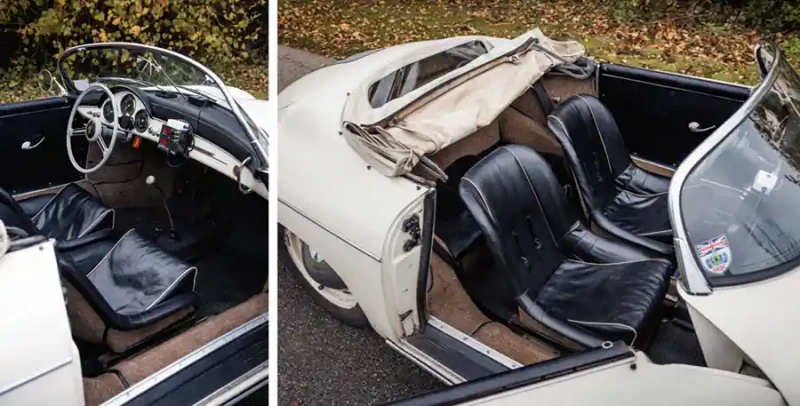
It turns out, this unsightly cosmetic addition was inspired by the 1966 film, Harper, starring Hollywood superstar and sometime Porsche racer, Paul Newman, as the eponymous hard-bitten private eye, who drives a cream 356 Speedster. Perplexingly, the red oxide ‘repairs’ on Alastair’s car appeared on the opposite side to those seen on the movie car. There were, in fact, two 356 Speedsters used in the making of the film, one of which was sent over a cliff, recovered and (eventually) restored. Are we looking at the second? “I don’t think so,” Angus avers, “but this Speedster was certainly made up to look like the star car. With no damage to repair, we simply painted over the red patches, but tried to make the paintwork look as bad as we possibly could in those areas. We mixed the paint from a dozen different shades of white, including off-white, dirty white and cream. It did quite an effective job, even if this 356 is now eight different shades of white!”
Alastair takes up the story. “Notwithstanding the red oxide stuff, which I couldn’t live with, this car was totally original. It hasn’t been restored and no welding has taken place. The seats and hood are factory items. As mentioned, the mileage was pleasingly low, although I added to the distance covered by immediately and vigorously campaigning the car all over Europe, adding an extra seven thousand miles to the odometer in the space of a month. Up until then, this Porsche had covered little more than thirty-two thousand miles in its entire life.”
Following the ‘corrective’ paintwork, a trackday preceded the road trip, as did a trial run to Cornwall and back from Greatworth Classics headquarters near Banbury. Alastair swiftly announced the Porsche as his favourite car. “Next thing we know, he was driving the 356 to Greece,” Angus laughs. “He and his girlfriend entered the Peloponnese Rally. It’s a regularity rally with reasonably restrained special stages and is, perhaps, a tad more sociable than many events of a similar nature. Regardless, the event was spread out over a week, after which, the pair drove to Italy, then around the eastern French and Spanish coastlines down to Tarifa, where a ferry carried them and the Speedster across the Strait of Gibraltar to Morocco, where they immediately took part in the Mille Maroc Classic Rally.” While journeying through southern Spain, however, the engine developed a misfire.
“Alastair contacted me to ask my opinion regarding remedy,” Angus continues. “The way I saw it, he had three choices. The first was to turn around and drive back to the UK, but we quickly reasoned that if he could make it back to Britain, he could probably complete the rally. The second option was to call for breakdown recovery, but we were worried about where the car might end up. This is a near half-million-dollar Porsche, don’t forget — there was no way Alastair wanted it to leave his sight. The third solution was to continue to Morocco and hope to find a mechanic who knows air-cooled engines. This seemed a sensible choice. After all, Morocco is full of old Volkswagens, meaning there was likely to be a host of garages familiar with air-cooled flat-fours, even if the unit they were being presented with was manufactured by Porsche, rather than VW.”
The third option appeared most appetising, but things got worse before they got better. “We were approaching Marrakesh, when the engine failed in dramatic fashion,” Alastair recalls. “It made a terrible noise and stopped dead. Investigation proved it had been built with a composite cam timing gear, which Porsche had been talked into using as a noise-reducing measure. The hub of the timing gear was aluminium, but the teeth were of a fibre-like construction, making less noise than if they were metal. It’s no secret this design was prone to failure in period. My car hadn’t covered the required thirty-six thousand miles to qualify for an all-aluminium replacement part courtesy of the manufacturer.
Ultimately, this was the cause of my breakdown woes.” Long story short, the teeth were falling off the cam gear — as Alastair accelerated and decelerated, cam timing was changing, which was causing the misfire. “We arranged recovery to a Moroccan classic car specialist, who turned out to be a massive 356 enthusiast,” he smiles. “He removed the engine, stripped it and discovered the fault. Amazingly, he was in possession of a 356 engine of the same vintage, leading him to donate its cam timing gear, which was an all-aluminium part. Granted, my car’s engine was taken to bits, but it hasn’t been rebuilt. It continues to make use of its original pistons, liners and bearings. Other than the timing wheel, nothing has changed.”
The work was completed in two days. Much to Alastair’s delight, the specialist taking care of the job offered his own 356 for the visitors to compete with during the first day of the event. “He then delivered my Speedster, fixed and running perfectly, to the hotel I was staying in. The handover was filmed for Moroccan television as part of a news item about the rally.” The patina Porsche picked up where the loan car left off, completing the event before being driven back to the UK. Whilst it is nothing like as full-on as the Dakar-esque FIA Rally du Maroc occupying the same October time frame, the Classic Rallye Mille Maroc is 1,500km across six days spent cruising southern Morocco, from Agadir on the Atlantic coast to Ouarzazate, Merzouga, finishing in Marrakesh. The Speedster emerged unscathed. With complete confidence in the Porsche, Alastair plans to participate in more historic rallying with the car in the near future — he’s a four-time veteran of La Carrera Panamericana (in an Austin A35 and AC Aceca) and sees no reason not to do it again. He’s made plans to preserve his car’s low-mileage engine accordingly.
“Angus is removing the original flat-four and replacing it with a freshly built unit. The idea is to keep the original powerplant safe in storage. It can be reinstated in future, whenever the car leaves my ownership, but I really don’t want to blow up such a valuable engine on a rally. I’m not altering anything else, though. The original gearbox is staying in place.” We suspect someone with a motor racing background as strong as Alastair’s may well be tempted to get the suspension beefed-up ahead of future competitive forays. There’s no question Greatworth Classics would rise to the occasion.
THE CLASSIC RALLYE MILLE MAROC IS 1,500KM ACROSS SIX DAYS SPENT CRUISING SOUTHERN MOROCCO
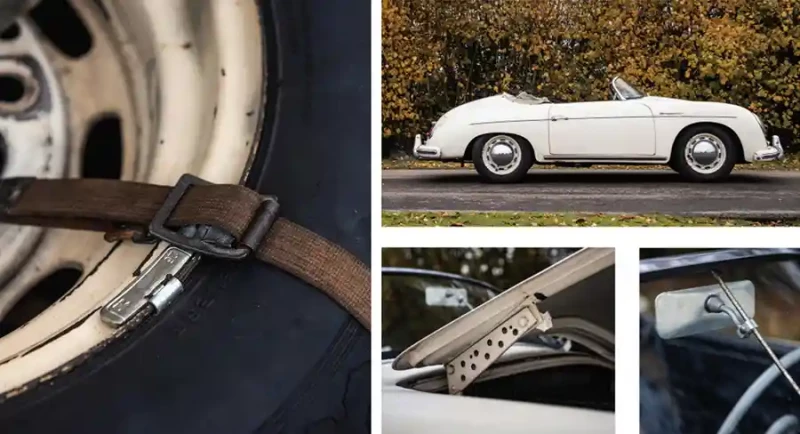
Above Is there a better drop-top classic Porsche for European road trips?
Above and right Though the car is fully original, Alastair has asked Angus to replace the engine with a rebuilt like-for-like to ensure the ‘matching numbers’ boxer doesn’t suffer irreparable damage on a road rally.
Facing page The engine’s originality caused problems on the tour, but was fixed thanks to the goodwill of a Moroccan flat-four specialist.
Above and below Rally timer and other navigation equipment was added in advance of the cross-Europe road trip, taking in not one, but two historic rallies.
Above Finally put to use as Porsche intended, this low-mileage, unrestored Speedster has been racking up major mileage at the hands of a McLaren man.
THE THIRD OPTION APPEARED MOST APPETISING, BUT THINGS GOT WORSE BEFORE THEY GOT BETTER


